The Turkish get up is a movement that can benefit athletes of all levels and sporting goals. Strength, power, and fitness athletes alike can increase overhead strength, core and shoulder stability, and lower body mobility by utilizing the Turkish get up (and it’s wide array of variations and alternatives) within a training program.
Therefore, in this article we will discuss the below aspects of the Turkish get up to help coaches and athletes better understand why, how, and when to program this total-body movement into their current training routine.
- Turkish Get Up Form and Technique
- Benefits of the Turkish Get Up
- Muscles Worked by Turkish Get Up
- Turkish Get Up Sets, Reps, and Programming Recommendations
- Turkish Get Up Variations and Alternatives
- and more…
How to Do the Turkish Get Up
Below is a step-by-step guide on how to properly set up and perform the Turkish get up.
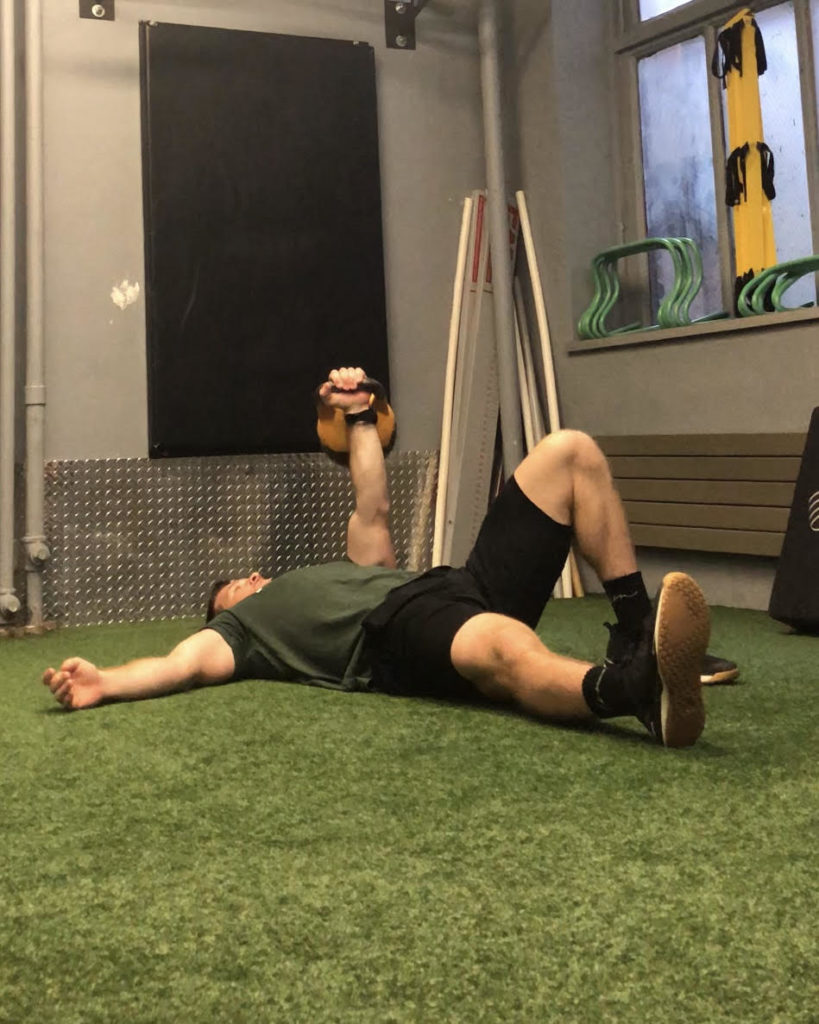
Step 1: Start by lying on the floor with a weight in the left hand.
The left legs should be bent at about 90 degrees and moved slightly outwards, with the right leg straight and the right heel pressing through the floor. The right arm should be straight and placed perpendicular to the body. Be sure to “pack” the shoulder blades together to stabilize the load so that the left wrist, elbow, and shoulder are in alignment.
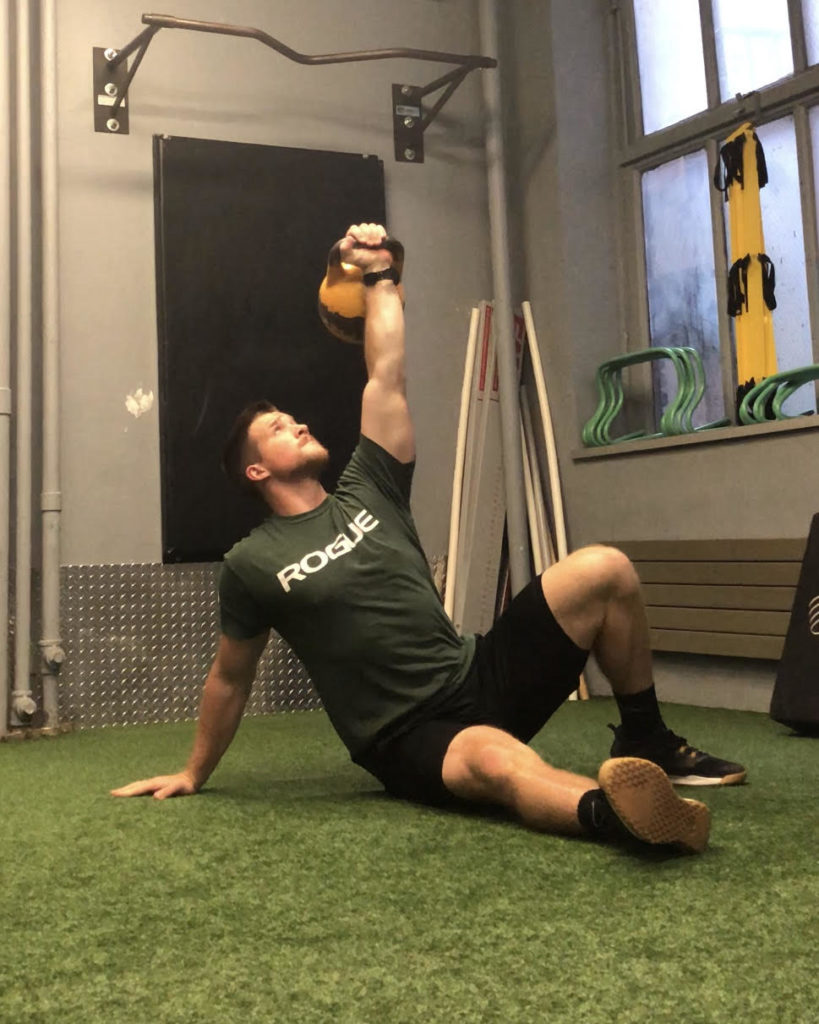
Step 2: Contract the core, and push through the floor left foot and the right elbow to come up to a seated position.
It is important to keep pressure through the right hand, and the left foot, as these are your two support structures.
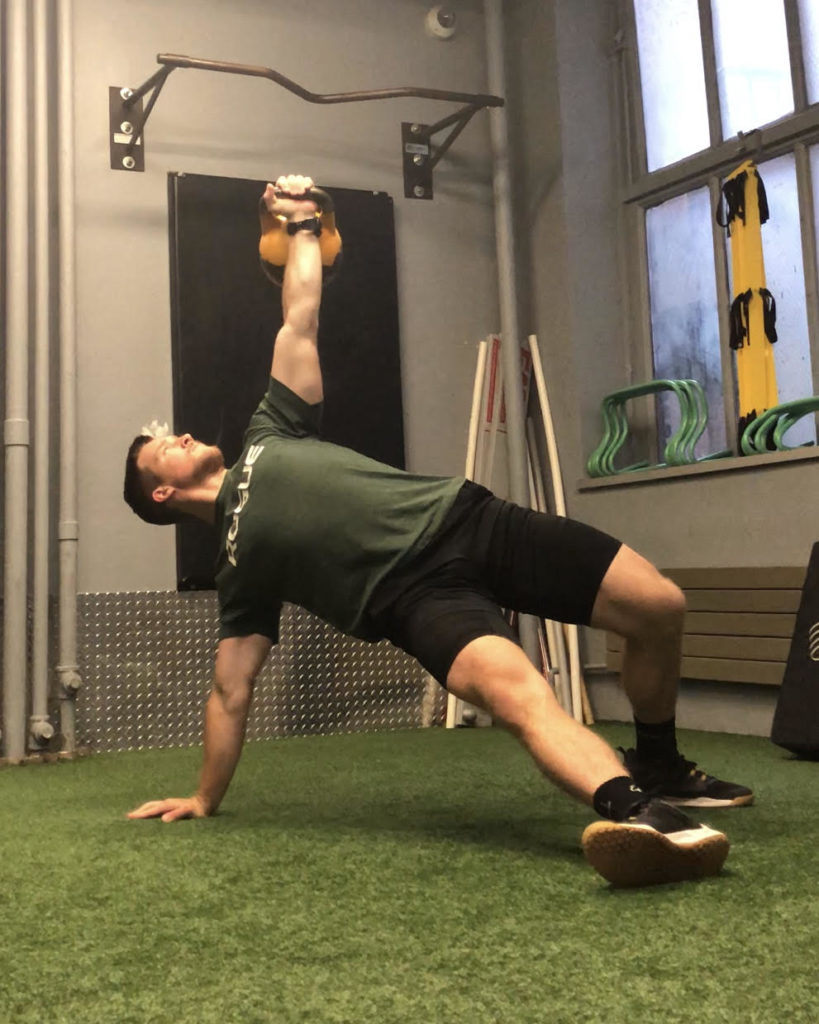
Step 3: Once in the seated position, lift the hips by performing a glute bridge with the left leg, keeping the right arm extended and stable into the floor.
Be sure the maintain vertical alignment of the left shoulder, elbow wrist, and load.
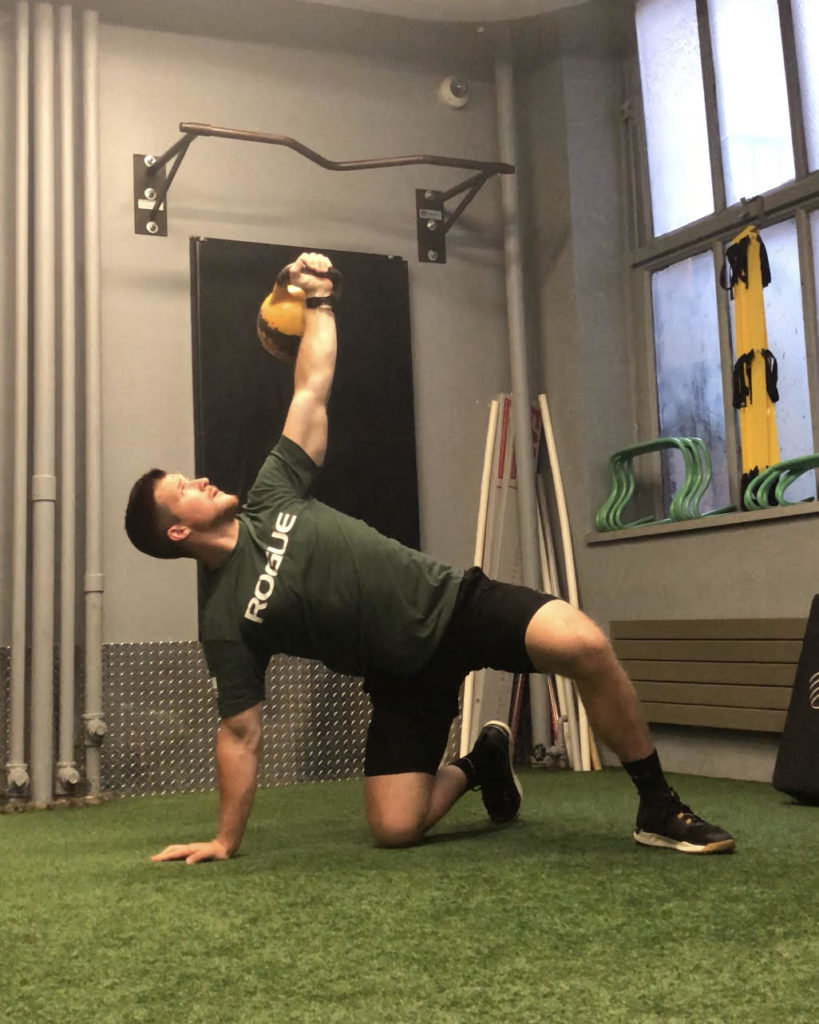
Step 4: From the elevated hip position, slide your right leg undeath you so that your right knee is placed directly under your right hip.
It is important to lift the hips high enough to allow the right leg to get placed fully underneath the hips. Additionally, be sure to keep the core tight and maintain vertical alignment of the left shoulder, elbow, wrist, and load.
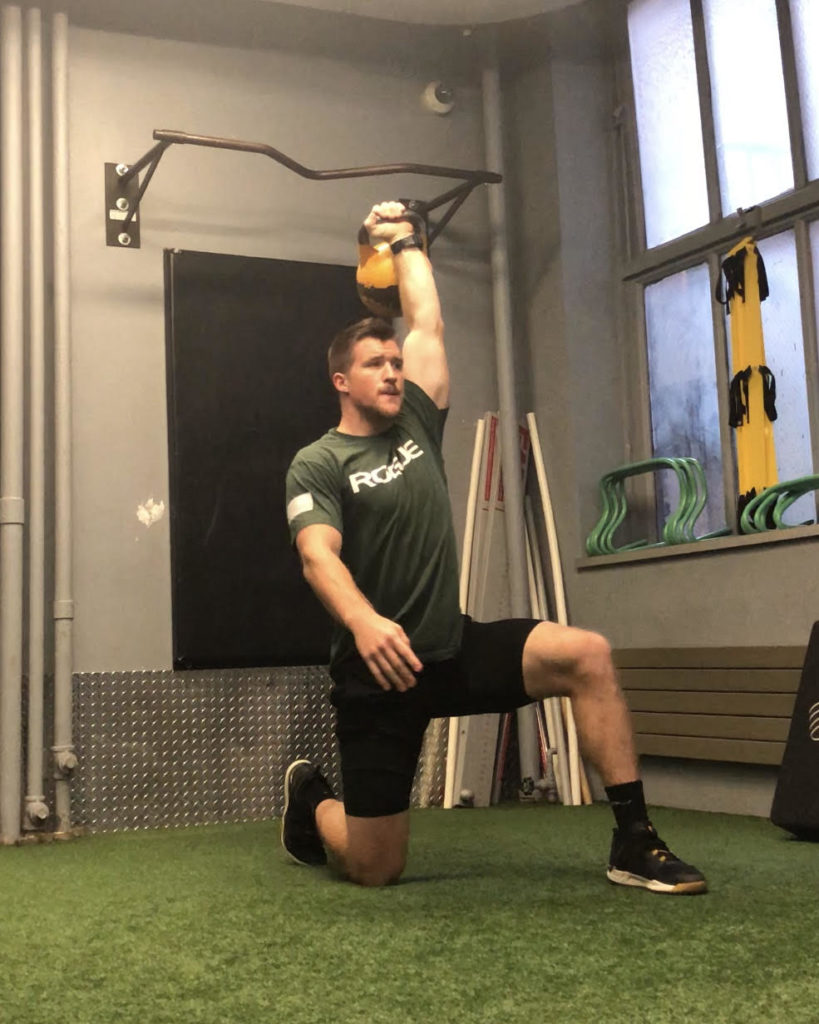
Step 5: Sit back onto the back foot and come vertical with your torso, assuming the bottom of the lunge position with the left foot forward and the load stacked vertically overhead in the left hand.
Be sure to take your time in the step, making sure to not let the core bend as you come vertical.
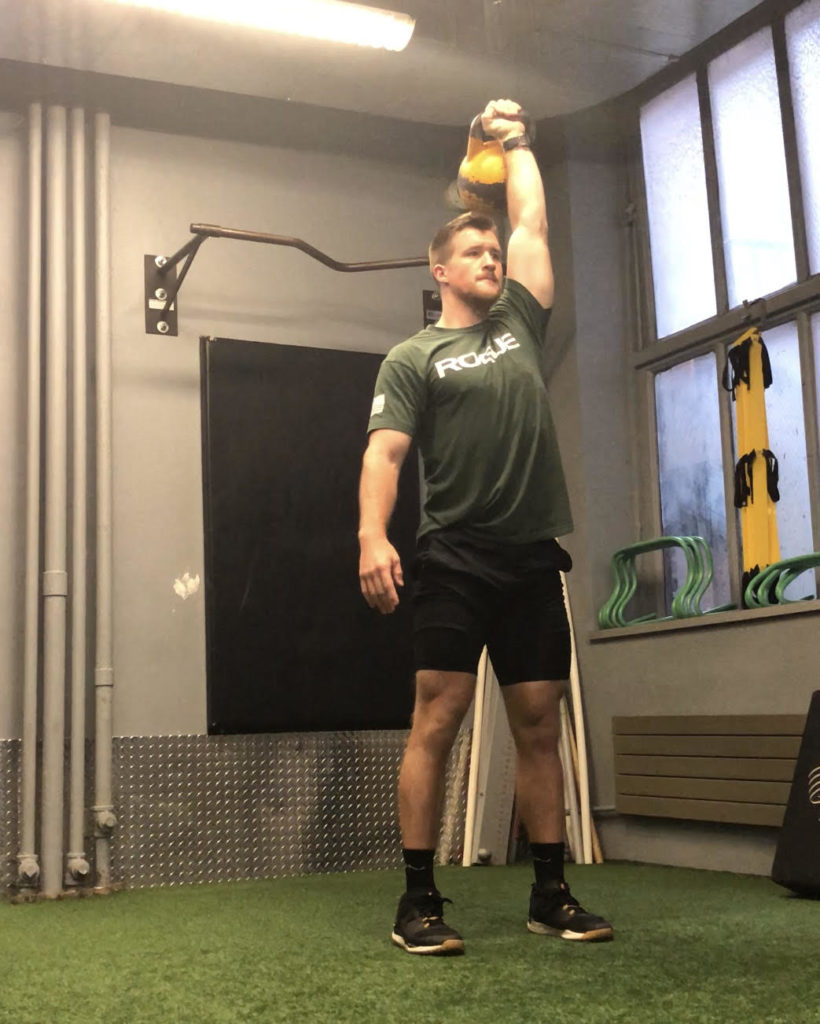
Step 6: Step forward while supporting the load overhead, and come stable in the standing position
From here, simply reverse the steps and repeat.
Muscles Worked – Turkish Get Up
The below muscles groups are targeted with Turkish get up. Note, that the Turkish get up is a total body movement, requiring integrated movements and muscle contractions across the body. This movement has high amounts of isometric contractions necessitating control and stability in addition to more dynamic joint actions at the hips, knees, and shoulders.
Shoulders
The Turkish get up has an athlete placing a load overhead in an extended fashion, resulting in the shoulders needing to contract to control the load isometrically. In addition, the athlete must work to stabilize the load properly and keep shoulder integrity (of the joint), which stresses the rotator cuff, deltoid muscles, and smaller scapular stabilizers in the upper back (see below).
Obliques and Abdominals
The core, specifically the obliques and abdominals, are stressed as the lifter is placed in an overhead position (the load overhead) and asked to move from the floor to the standing position, and back down. The athlete finds themselves in positions that can compromise the spinal integrity if not set up properly, which is done so via proper joint movement, technique, and muscular control and stability within the abdominal and obliques.
Gluteals
Proper hip function is key in the Turkish get up, as this allows an athlete to stabilize a load overhead without compromising pelvic and spinal integrity. It is also key for the movement from the floor to the standing position, as the lifter must be able to internally and externally rotate the hip, extend, and move freely under load. The glutes (glutes) are responsible for stabilization of the pelvis (which aid in controlling the body in certain positions) and increasing an athlete’s strength to lift the hips from the floor, stand up, and properly recover (come back down) towards the floor.
Scapular Stabilizers (Upper Back)
The scapular stabilizers (such as the rhomboids, rotator cuff muscles, and posterior deltoids) are all highly involved in this movement, as they work to increase stability of the load overhead while the shoulder joint must adapt to the dynamic movement and mobility requirements as the lifter goes from lying down to overhead. This is also a good exercise to help reinforce proper “packing” of the shoulder blades that can then be applied to most pressing movements.
https://www.instagram.com/p/BnczBpCBFrG/
Benefits of Turkish Get Ups
Below are benefits of the Turkish get up that coaches and athletes from most strength, power, and fitness sports can expect when implementing Turkish get ups into a training regimen.
Shoulder Stability
The Turkish get up can increase unilateral shoulder stability due to the demands placed upon the rotator cuff and upper back muscles as the athlete moves from the floor to the overhead position while supporting a load properly overhead.
Unilateral Overhead Strength
Overhead strength and stability is key for nearly every strength, power, and fitness athlete. Unlike other overhead lifts, the Turkish get up can stress unilateral overhead stability, under high amounts of load, while the lifter must move through a fuller range of motion. The need for proper spinal alignment and core stability limits the athlete’s ability to compensate for poor shoulder mobility (meaning they cannot simply hyperextend the spine), forcing them to properly learn and establish a better relationship with an overhead load.
Lower Body Mobility
The Turkish get up challenges an athlete’s hip, knee, and even ankle mobility as they must perform deep flexion angles and internal rotation as the perform lying bridges, lunges, and non-sagittal positions. By performing this movement under load, the athlete is forced to maintain rigidity and not compromise alignment, forcing the hip joints to move freely. If an athlete cannot perform the Turkish get up with mobile hips, hip mobility should then be addressed via other corrective stretches and means.
Core Stability
Core stabilization is necessary for the Turkish get up during nearly every stage of the movement. The lifter must work to maintain proper spinal positioning and wrist flexion, extension, lateral flexion, and rotation of the spine spine (especially with a load overhead).
Total-Body Awareness
Total body awareness, also called proprioception is often not discussed a lot in strength, power, and fitness sports. The ability to remain in control of joints, muscles, and movement both with and without loads is key for injury prevention, speed (in the Olympic lifts), and the ability to correct movement on the go (if need to save a lift). The Turkish get up can help athletes establish greater muscle coordination, stability, and balance.
Who Should Do Turkish Get Ups?
The Turkish get up is beneficial for nearly every athlete and individual, as it challenges core stability, upper body strength, and total body mobility. Below are the main groups of individuals that can benefit from including these into a training program.
Turkish Get Ups for Strength and Power Athletes
The Turkish get up can be a beneficial warm-up, functional strength, and/or corrective exercise for strength and power athletes. The ability to maintain overhead stability during movement is key in most lifts in these sports, and/or is helpful in preventing injury at the shoulder joint. In addition, the Turkish get up can be a helpful exercise to have athletes move in non-sagittal movement patterns to diversify their fitness.
Turkish Get Ups for CrossFit/Competitive Fitness Athletes
Similarly to strength, power, and general fitness athletes, the Turkish get up can be used to increase shoulder and core stability and help increase general hip function and movement.
Turkish Get Ups for General Fitness
Turkish get ups are useful for nearly every individual, with or without loading. The Turkish get up can help to improve movement, establish greater core strength, and enhance shoulder stability. Note, that this movement should be taught slowly and with light loads prior to adding weight to minimize injury.
How to Program the Turkish Get Up
Below are two primary training goals and programming recommendations when utilizing the box jump into specific programs. Note, that these are just general guidelines, and by no means should be used as the only way to programm Turkish get ups.
Movement Integrity – Reps and Sets
This should be done with bodyweight or light loads, making sure that the lifter can perform a stable and controlled positioning at all phases (see how to perform a proper Turkish get up above).
- 3-4 sets of 3-5 repetitions, resting 2-3 minutes
Strength – Reps and Sets
For more strength and stability focused work, lower reps with more sets can be used, allowing the athlete to rest adequately in between sets.
- 3-4 sets of 1-3 repetitions, resting 2-3 minutes
https://www.instagram.com/p/BnlwrQBhQzt/
Turkish Get Up Variations
Below are three (3) Turkish get up variations that can be used by coaches and athletes to keep training varied and progressive.
Double Kettlebell Turkish Get Up
This Turkish get up variation is done by having two kettlebells being used, on in each hand. This is an extremely challenging get up variation that stresses higher amounts of core stability, shoulder strength and mobility. This is not a variation for beginners.
Tempo Turkish Get Up
When learning the Turkish get up, it can be helpful to have an athlete perform each step above (see the above how to guide) in which the will then pause at each step for a few seconds, establishing greater control and awareness. In addition, this can increase time under tension, making the athlete increase control and coordination under load.
Barbell, Dumbbell, and other Odd Object Turkish Get Up
Turkish get ups are commonly done with kettlebells, however dumbbells, barbells, and even human’s (yes it has been done) have been used as loads. By using other forms of loading the athlete can develop greater shoulder stability, wrist strength and stability, and open up the versatility of the Turkish get up in a program.
Turkish Get Up Alternatives
Below are three (3) Turkish get up alternatives coaches and athletes can use to increase movement integrity, core strength, and overhead/shoulder stability.
Bodyweight Get Up
The bodyweight get up is done identically to the Turkish get up, however no load is used. The goal of this exercise is to increase an athlete’s understanding of the steps they should be taken to perform a Turkish get up and to help increase hip mobility. This can also be done with a light yoga block as the load to keep athletes aware of proper arm placement during the get up.
Single Arm Overhead Lunge
The single arm overhead lunge (reverse, forward, walking, etc.) is a viable alternative to the Turkish get up as it challenges many of the same shoulder stabilizers and core muscles as the get up. This can also be used to increase strength and movement that can then be applied to the Turkish get up.
Windmill
The windmill, which can be done with kettlebells or dumbbells, is an exercise that is very similar (joint actions) to the Turkish get up. This movement challenge shoulder stability and strength, core stability, and hip mobility; all of which are necessary for the Turkish get up.